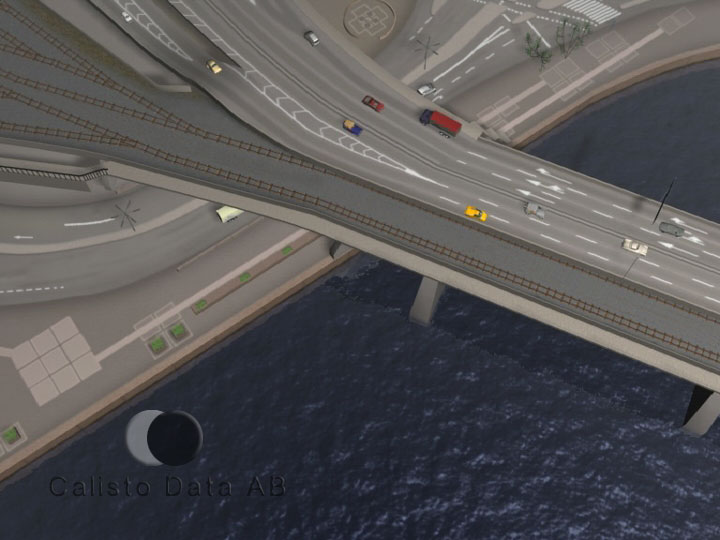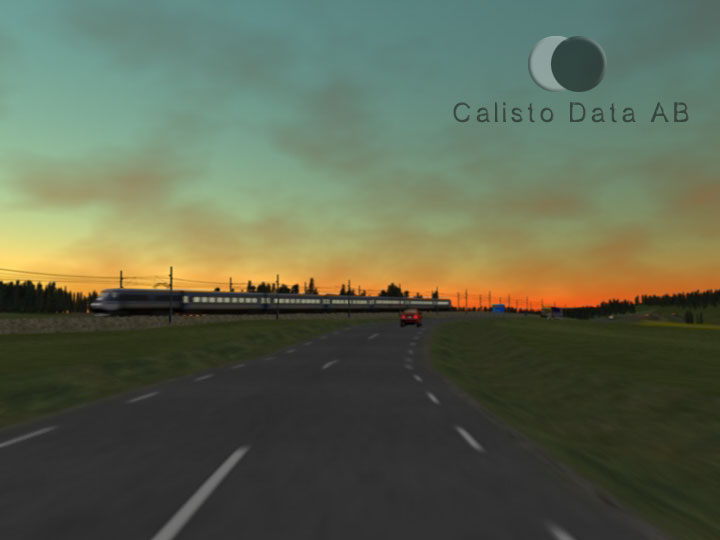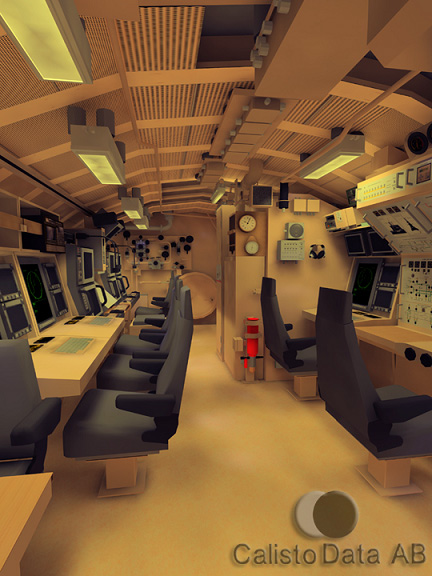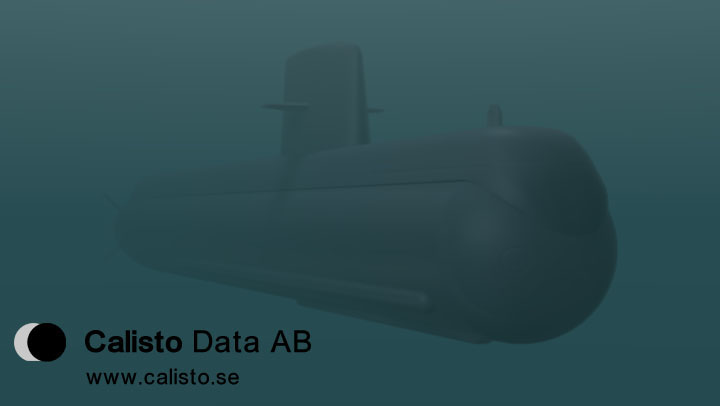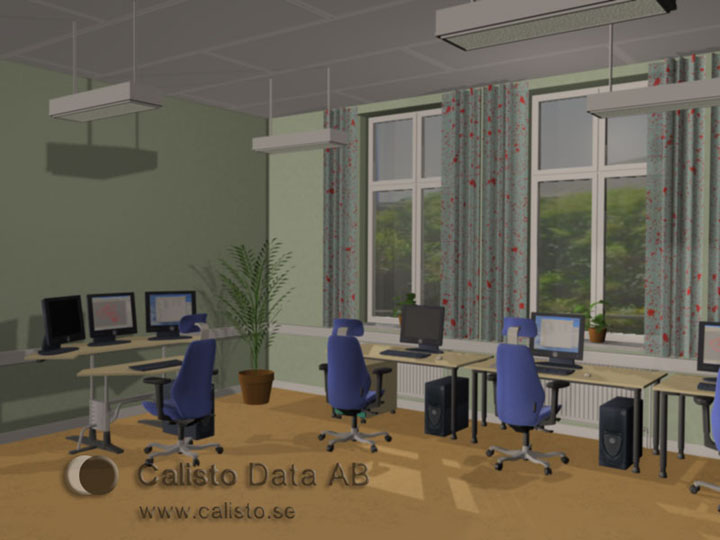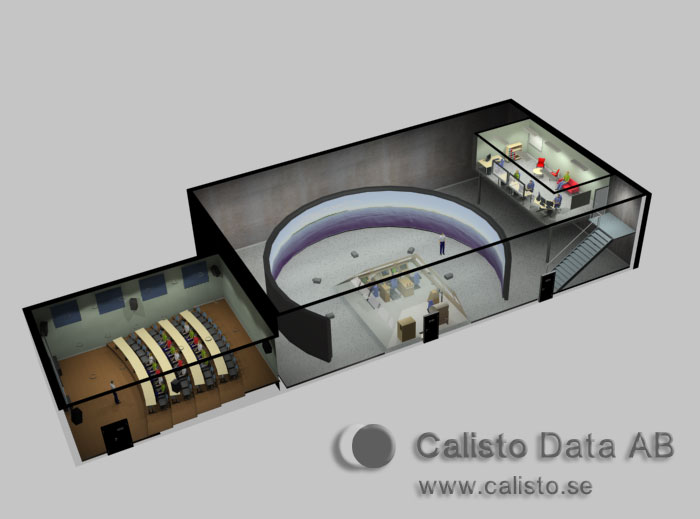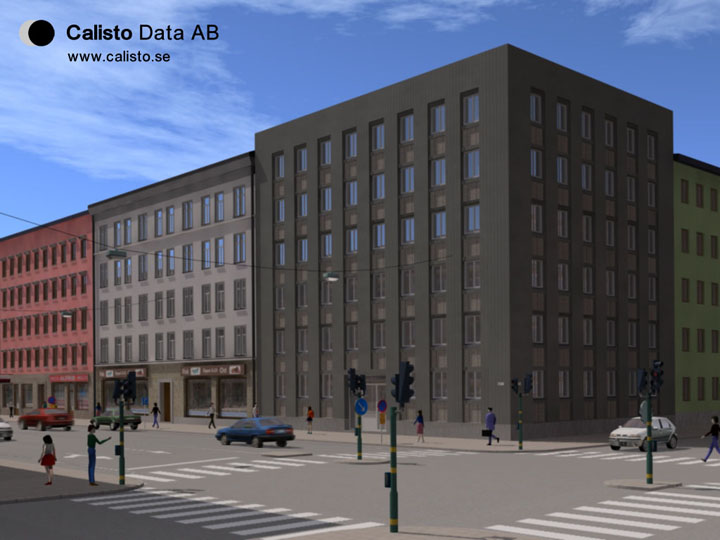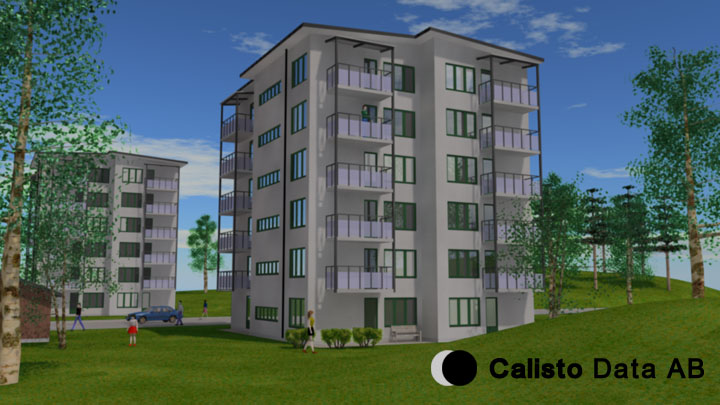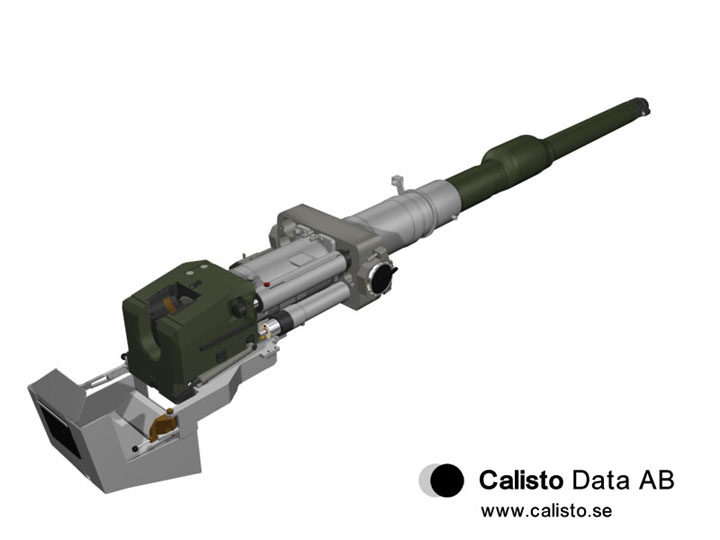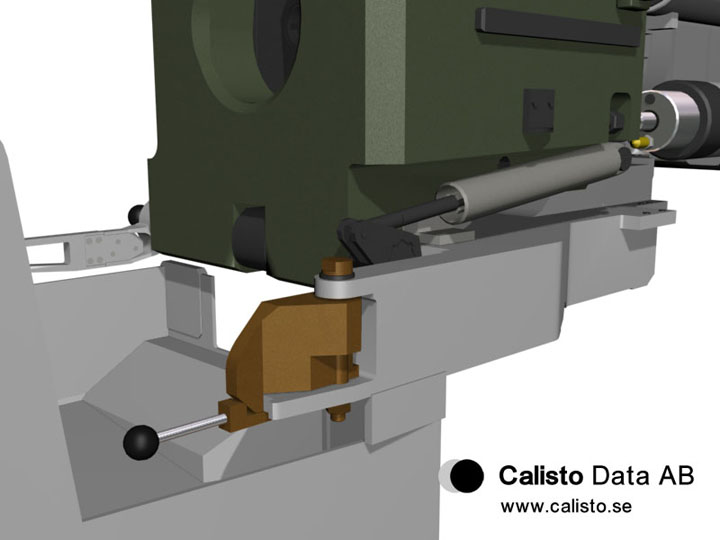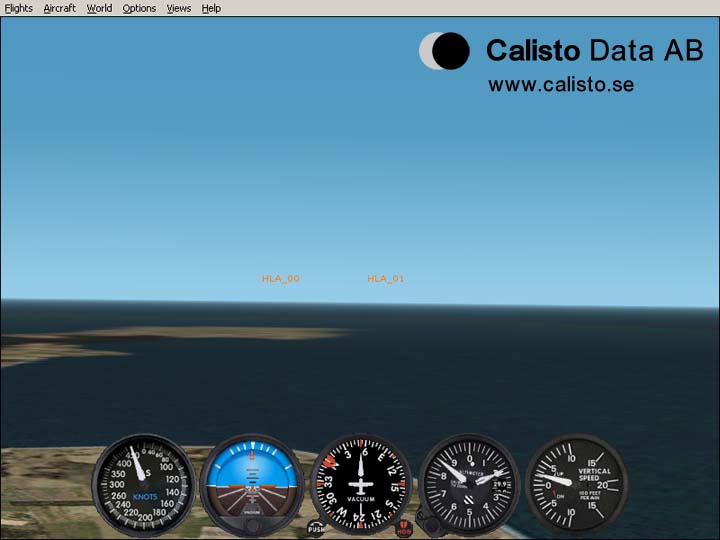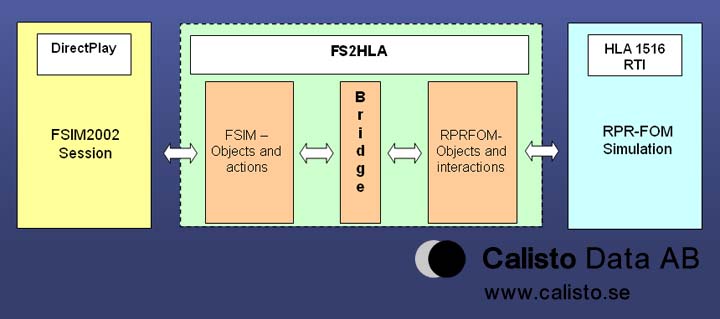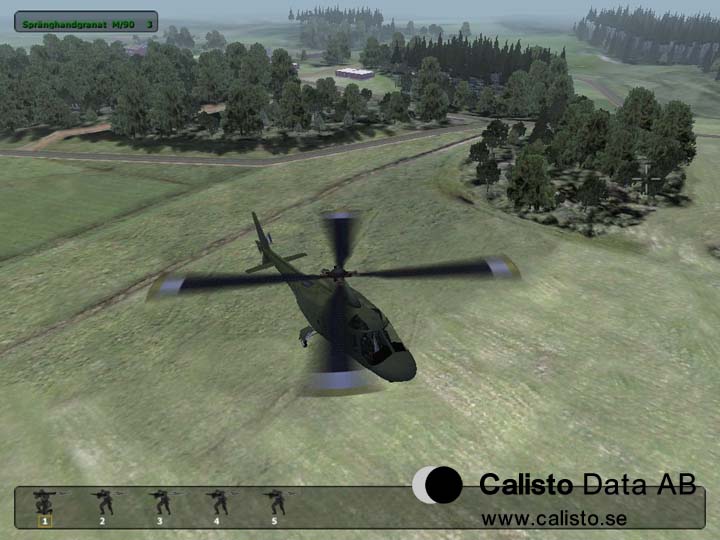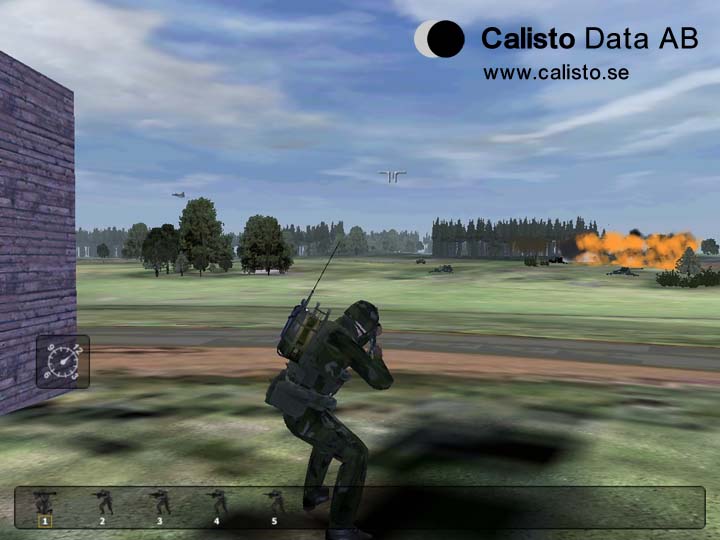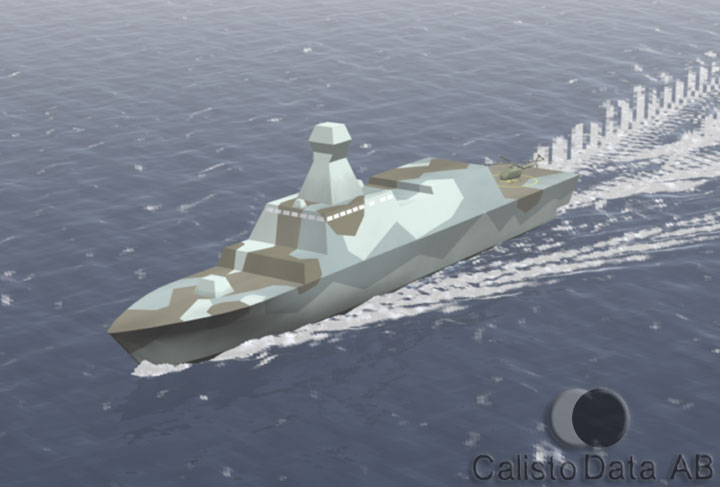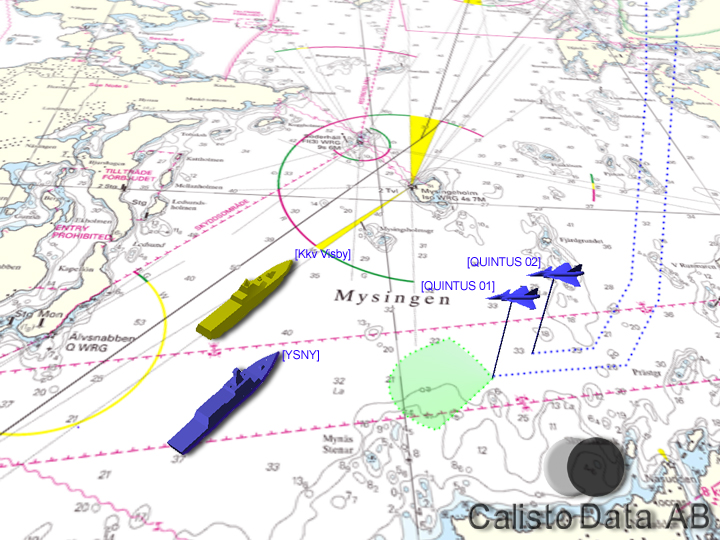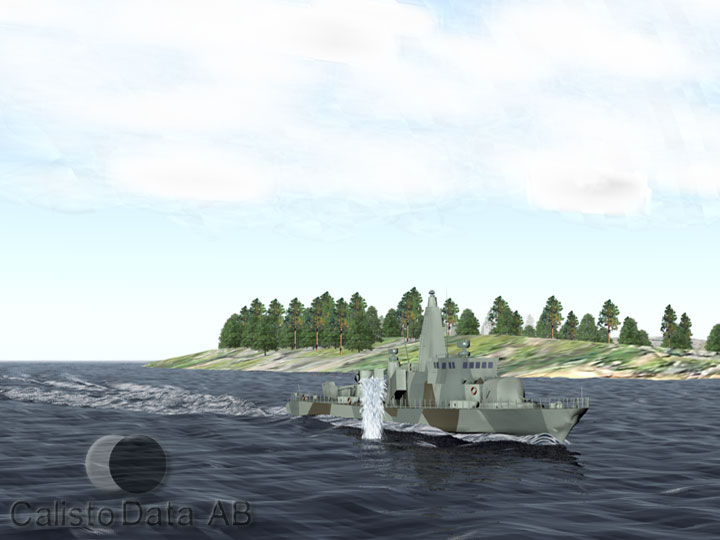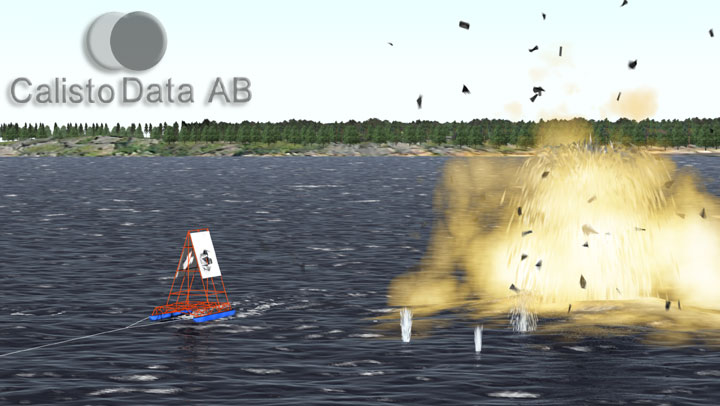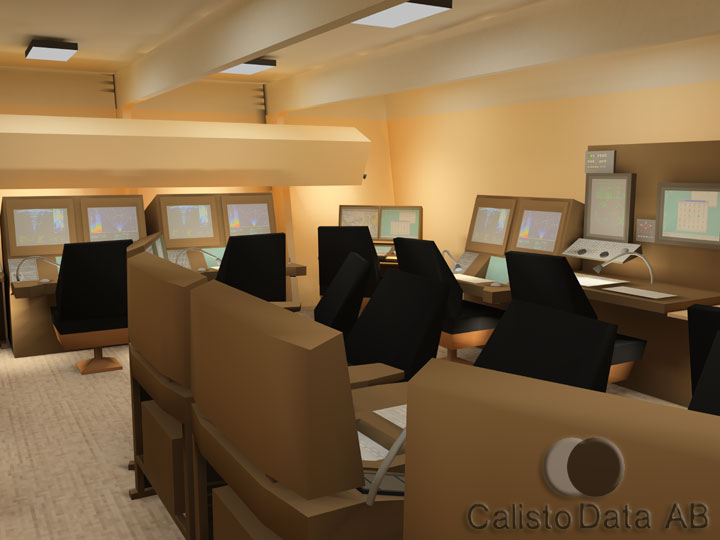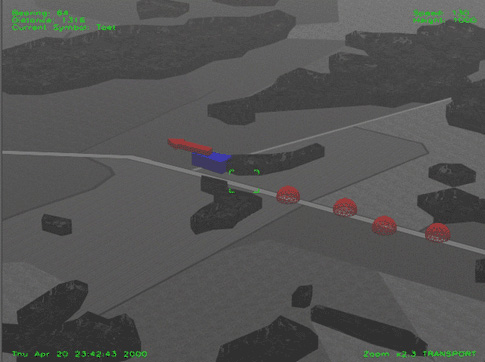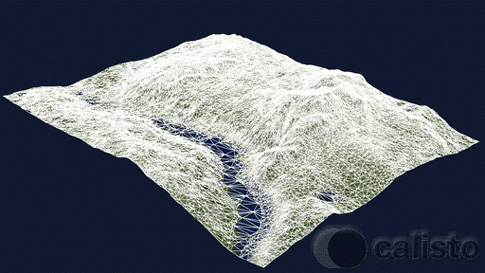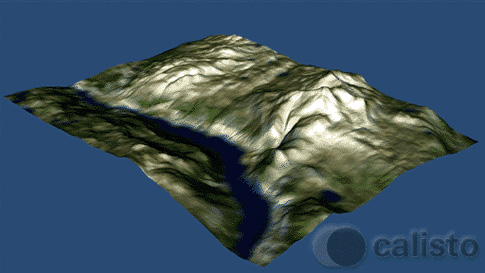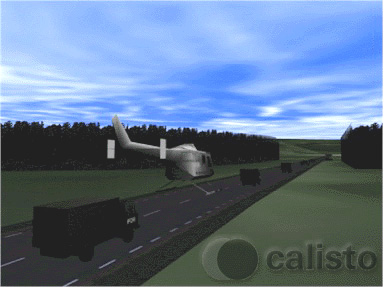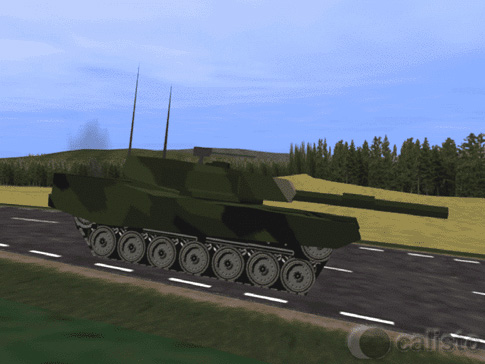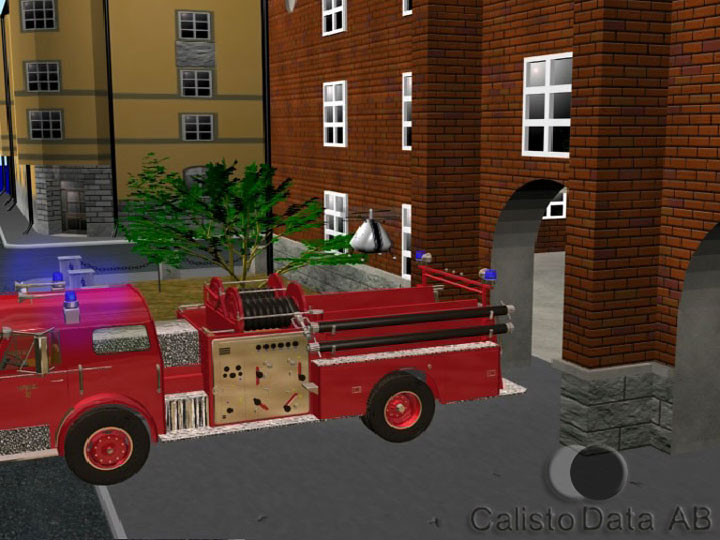Corvette Visby
The Visby class corvette is the Swedish Navy's latest surface vessel. It was designed using stealth technology and several other advanced features. SBA – simulation based acquisition – was used extensivly in the project for physical design and simulation of various attributes. Calisto participated in several projects utilizing visual simulation technology, e.g. design of bridge and tactical combat command center, camouflage design and several visualisations and demonstrations for marketing and information purposes.
Visualisation of Public Works Projects
Animations and real-time (interactive) 3D graphics can be used to visualise large public infra-structure projects such as roads, bridges and railways. Shown here are parts of a busy traffic junction in central Stockholm and parallel tracks and roads in the countryside near lake Mдlaren, Sweden. In the latter case effort was put into making the terrain look realistic and typically "Swedish". The models were created using maps, drawings and satelite imagery.
Mid-Life Upgrade of Gotland Class Submarine
As part of the work in preparing for the mid-life upgrade of the Gotland class submarines of the Swedish Navy, Calisto has made a model of the interior of the submarine using CAD data from Kockums shipyard. The model will be used by FMV (the Swedish Defence Materiel Administration) as a basis for a collaborative design process using virtual reality technology, to facilitate specification of the requirements for the future interior. The model has also been used to make high-fidely animations of walk-throughs of the existing interior with full simulation of lighting conditions.
Architectural Visualisation - Exteriors
Visualisation (animation as well as real-time) can be used to give a greater understanding of abstract building plans, showing clearly what will actually be built. The first example is from a former school in Karlskoga, Sweden, that is beeing refurbished for advanced office use. The 3D model was rendered in a short animated walk-through film, as well as (partially) a real-time Shockwave application for use on web pages that allows the user to navigate the model freely in real-time. The second example is a possible layout for a marine bridge simulator, including control, debriefing and instruction facilities.
Architectural Visualisation - Exteriors
Illustrations of buildings, roads etc. can play an importang task in communicating in building and construction projects, within the project during development phases and when showing the project to customers or the public.
Computer Aided Education - Leopard Tank
As part of a package for computer aided education for mechanics working on the Leopard Tank for the Swedish Army (Datorstцdd Utbildning (DSU) Stridsvagn 122), Calisto provided models, 3D-illustrations and animations of various fixtures and procedures.
Microsoft Flight Simulator to HLA Adaptor
Calisto has developed an adaptor to connect Microsoft’s Flight Simulator to HLA based simulation federations. There are several advantages to being able to use a low-cost commercial product in this fashion, for example to control entities requiring a man-in-the-loop operator in cases where a high-fidelity flight simulation package is unnecessary or as a way of providing simple visualization of a simulated scenario on standard PCs. It can also be very valuable as a development and debugging tool when developing and integrating a complex simulation federation. The adaptor uses a commercially available HLA 1516-compliant RTI and the RPRFOM object model. The software can be tailored to other RTIs and federation specific object models. The software was originally developed for the Swedish Defense Materiel Administration (FMV) and the Swedish Defense Research Agency (FOI) and is used in projects within these agencies. The software is freely available for Swedish defense projects and is available on a commercial basis for other projects.
Commercial Computer Games as a Basis for Military Training Simulators
Calisto has participated in a Swedish Defense study in the possibilities of using COTS computer games as a basis for military training simulators. The study had the Swedish Army Combat School in Kvarn as recipient of the results. The Combat School also contributed with domain specific knowledge. One of the results of the study was a simulation and visualization of a surveillance mission using Forward Air/Ground Controllers (FAGC) and a UAV to fight hostile artillery units. The application was built as a modification to the game Operation Flashpoint:Resistance. A 50x50 km terrain model was developed by Calisto with a high-resolution 1x1 km area covering a MOUT/FIBUA exercise area at Kvarn. The demonstrator uses a version of the excellent Swedish Forces Pack v4.0 developed by the Swedish Forces Team. The Swedish Forces Team also created custom scripts for the demo. The scenario was developed by teachers from the Army Combat School.
VP-MYS (Virtual Prototype for new surface ship)
VP-MYS stands for Virtual Prototype Maritime Surface Vessel and is an HLA based simulation framework for the next generation of Swedish Naval Combat Ships. Calisto developed an advanced HLA-compliant maritime visualization using MPI Vega/Creator, built new and adapted existing 3D models of ships and also built a geospecific 3D-terrain covering parts of the Stockholm archipelago. Within the project Calisto also contributed with expertise in visual simulation for a similar NATO 6 project called NIREUS .
VP-MYS (Virtual Prototype for new surface ship)
VP-MYS stands for Virtual Prototype Maritime Surface Vessel and is an HLA based simulation framework for the next generation of Swedish Naval Combat Ships. Calisto developed an advanced HLA-compliant maritime visualization using MPI Vega/Creator, built new and adapted existing 3D models of ships and also built a geospecific 3D-terrain covering parts of the Stockholm archipelago. Within the project Calisto also contributed with expertise in visual simulation for a similar NATO 6 project called NIREUS .
StriPbv90 (Virtual prototyping)
STRPBV90 is an armored personel carrier modified for use as a command and control vehicle. The current physical layout of the vehicle has several problems, in ergonomics and suitabilty for the task. A project was initated at FMV (Swedish Defence Material Administration) for designing a new interior of the vehicle. Calisto designed a 3D virtual prototype of the vehicle which was used and modified in a collective design process involving several users and specialists. The use of VR techonolgy helped speed up the process, facilitate user involvement, cut costs and improve the design proposal.
Advanced Surface Target System
This is an example of how 3D visualisation technology (in the form of several short animated sequences) can be used to illustrate and discuss doctrine, tactics and new threats. The puropse of the project was to illustrate the particular challenges for existing naval resources of dealing with small high-speed surface vessels (in a low intensity/terrorist type scenario).
Lighting study for tactical C2 center
Computer generated 3D graphics can be of great use in architectural and interior design contexts. An example of this is the lighting visualisations of command and control rooms that Calisto has done for FMV. The visualisations helped the design groups choose the optimal lighting solution before the actual room was built.
LedsysT Federation 1, scenario development
LedsysT Federation 1 is a demonstrator (HLA based simulation) for the future Swedish Network Based Defense (NBD). Calisto is part of serveral workgroups within the project, dealing with coordinate handling, simulation architecture and scenario development. We also contribute with expertise within the areas of visual simulation and distributed simulation
UAV Simulator
This simulation was made for the Swedish Army to show how Augmented Reality can be used to enhance a UAV (Unmanned Aerial Vechicle) operator's view. Sensor data is displayed using 3D symbology that is superimposed on the live video feed from the UAV. The interface also allows the operator to assign different symbols (eg unit symbols) to features on the video feed. This data can be output (in real time) to other mapping and command and control systems.
Terrain Modelling
This model is an exampel of a terrain model adapted for real-time performance. The area shown is Еreskutan - one of Sweden's most popular ski resort areas. The model uses three different level-of-details depending on the distance from the observer to the model. The model uses a Triangulated Irregular Network (shown in the top picture) constructed from digial elevation data (50 meter resolution). Satellite images (25 meter resolution) were superimposed on the mesh.
Telepresence
This demonstration was done for the Royal Swedish Academy of War Sciences 200th anniversary symposium. The purpose was to show how telepresence can be used to visualize low bandwith real-time data sent over a satelite link to give a better understanding of a developing situation. The data generated in Bosnia by the Swedish UN battalion in Tuzla was used to give a remote briefing by the on-site commander to the audience in Stockholm, Sweden.
After Action Review (AAR)
This project was done by Calisto as a sub-contractor to one of Sweden's major developers of military training equipment for live exercises. The purpose was to show how 3D visualisation of logged exercise data could enhance presentation and understanding in the AAR phase of training debriefings.
Product Visualisation of a new UAV
In this project we helped Volinvest AB make a visualisation of their product concept for a UAV (Unmanned Aerial Vehicle). An animated film showing several scenarios in which the UAV could operate was made. Shown here is a picture from a traffic accident scenario where the fire brigade is launching the UAV.


